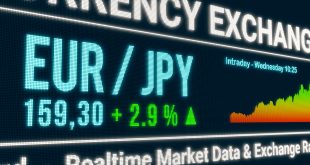The Gold Index has suspended two successive days of gains and retreats towards the 20-DMA after bouncing off the 200-DMA amidst a sour market sentiment during the current trading session as US traders come back from a three-day weekend with positive attitude towards the US dollar and US Treasury yields. At $1842.36, the Gold Index remains on the defensive front, almost 0.50% down.
Gold’s Tuesday price action witnessed a test of the 200-DMA at $1840.86, quickly rejected, as depicted by the candlestick. However, gold bears appear to be leaning towards the 20-DMA at $1846.76, maintaining the spot price seesawing in the $5 range. It’s worth noting that the Relative Strength Index (RSI) is at 43.06, in bearish territory, aiming lower, meanings that gold seems poised to break to the downside.
The factors mentioned above, alongside fears of inflation anchored above the US Federal Reserve 2% target, caused a shift towards safe-haven assets. Meanwhile, 10-year breakeven inflation expectations are rising up to 2.63%, signaling that investors are not sure about buying the dip.
Investors’ mood shifted negatively, as witnessed by global equities falling. The US Dollar Index, a gauge of the greenback’s value vs. a basket of rivals, advances 0.50%, sitting at 101.811, underpinned by elevated yields on US Treasuries. The 10-year benchmark note rate is gaining five bps, up at 2.868%.
China’s released its official PMIs for Mat, which increased by 49.6 from 47.4 in April, signaling a minimal recovery after May’s Covid-19 lockdowns. Additionally, reports on Monday’s Asian session said that Shanghai and Beijing would ease some of their restrictions to boost economic growth.
The US economic calendar released Housing data, which came mixed but close to forecasts. The highlight was May’s CB Consumer Confidence, which came at 106.4, better than the 103.9 expected. The report showed that inflation expectations for one year are at 7.4%, lower than April’s 7.5%.
The Fed Regional banks keep releasing their Manufacturing Indexes ahead of June’s 1 ISM Manufacturing PMI. Chicago’s PMI for May rose by 60.3, higher than the 55 expected, but the Dallas Fed Index contracted to -7.3, lower than April’s reading.
Gold’s path of least resistance is tilted to the downside. The XAU/USD’s first support would be the 200-DMA at $1840.86. Break below would expose the 4-year-old upslope trendline around $1830-34, which, once cleared, would send gold tumbling towards the Bollinger’s band bottom band at $1805.44.

 Noor Trends News, Technical Analysis, Educational Tools and Recommendations
Noor Trends News, Technical Analysis, Educational Tools and Recommendations




